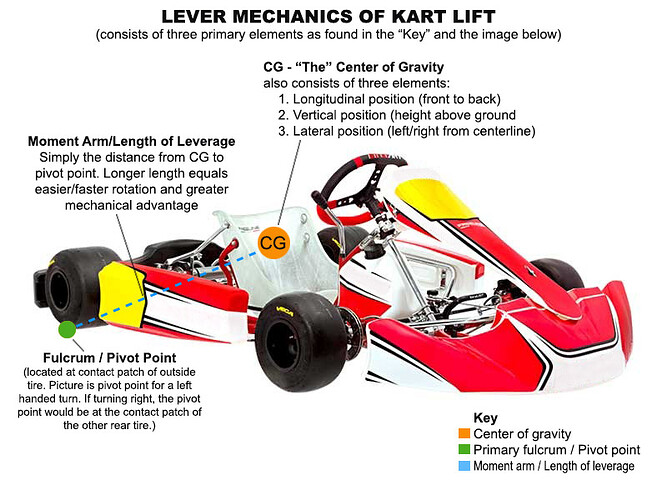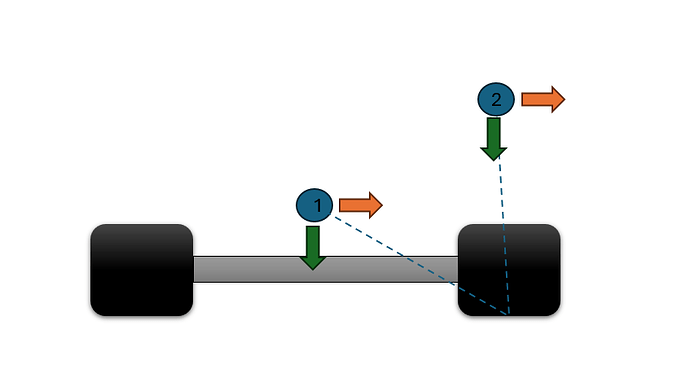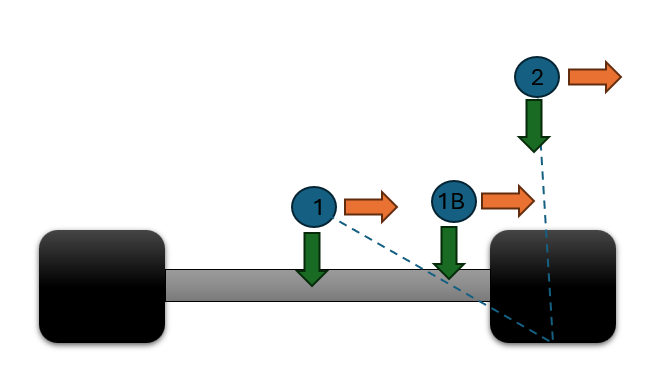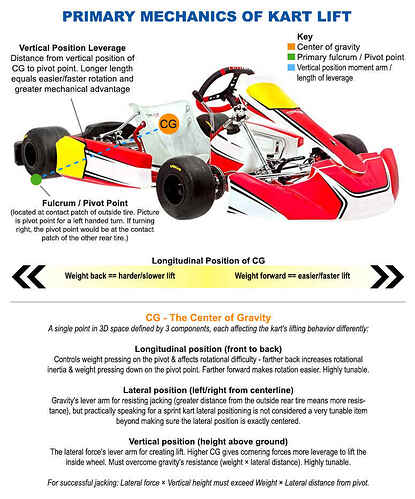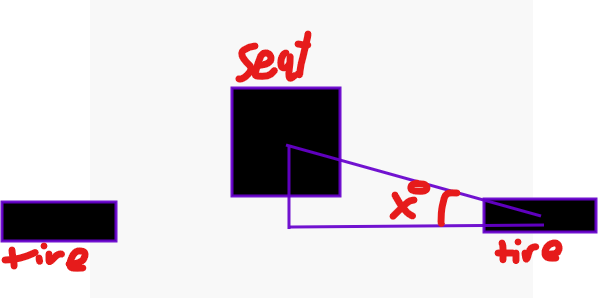Question. If you are able to create your weighted list, how would you implement that information on raceday? Specifically, how do you expect it to benefit you?
In retrospect, I guess the list I posted originally functioned as a vehicle to kick off deeper thinking of lift dynamics. That list was scored against 1 general context, “lift”, without any further distinction, which as was pointed out, was overly simple.
My next step will be to score it again, but on the basis of the three-contexts I listed above (steering/mechanical lift, chassis flex caused by lateral G loading, and changing the fulcrum and/or moment arm to affect the rate of lift).
In terms of what use this will be on a race/practice day, I think would depend on where a person is in their personal experience, but eventually may not really be needed once they have an understanding of what to change in order to affect the specific aspect of lift they want to alter. But actually it could still be useful to sanity check a single kart’s settings, or compare two karts to see why and how they behave differently.
For now, I’m hopefully working a lot out on ‘paper’ while not waiting for track time, and am better prepared when I do get to the track.
I’ve followed up previous discussions here with a bit more thinking, as well as just physically interacting with a kart in the garage in order to solidify basic lift concepts in my overfull head.
Ultimately it ended with me making the graphic below.
I’ll pose some corrections on the moment arm thinking.
It isn’t simply the length of the arm. What you have to consider are three distances .
1 - The lateral distance of the CG relative to the fulcrum tire. The greater this distance, the more resistance to lift. Imagine your CG is over the right side. On left turns, this distance is zero and you get a lot of lift. On right turns, this distance is like a meter, and you sit flat.
2 - The vertical distance of CG to the ground. The higher this distance, the more lift because lateral Gs have greater ‘leverage’ relative to the rear tires.
3 - The longitudinal distance of CG to the axle. The greater this distance, the more jacking you get from steering (because there’s less stiffness applied to [1]) but the less lateral jacking for the same reason (less stiffness between the CG and the loaded rear tire).
[1] and [2] are why you can raise the ride height or narrow the rear track and both do similar things.
#1 - You have the right relationships between CG and the correct placing of the fulcrum points, but the outcome of the relationships - specifically with respect to the effect of the moment arm - is opposite of what really happens. (longer moment arm ALWAYS provides more leverage for the same force, whether lateral or longitudinal)
a) Left turns. The CG is on the right side of the kart, the fulcrum/pivot is at the RIGHT rear tire’s contact patch, the moment arm is tiny since the distance to the fulcrum to CG is so close. It is very difficult to make left hand turns for lack of a tiny moment arm (aka leverage).
b) Right turns. The CG hasn’t gone anywhere it’s still on the right side, however now the fulcrum is at the LEFT rear tire’s contact patch, and the distance between the fulcrum and CG is really large, thus making turning right very easy/fast.
If you consider the situation from a practical point of view for a minute it will likely make intuitive sense: Add 100lbs to the right hand side of a kart (so that the lateral point of CG is gross over-allocated in that direction), and what direction is that kart going to want to easily turn in? What direction will it be harder to get the kart to turn?
#2. The diagram fully accounts for the points about the vertical distance of CG as is.
#3. In terms of the physics involved, the axle and the steering are just things that act on the primary leverage system. The diagram also fully accounts for the idea that creating a larger distance to the center of gravity longitudinally increases the moment arm/leverage and therefore lift.
Unrelated to the above response, I’ll mention the obvious fact that there are numerous secondary leverage systems on a kart, and they may have profound effects on how the kart handles, but ultimately they’re all acting upon/through the primary leverage system. The graphic in no way makes any attempt to explain any secondary system, nor does it mean that they’re not important or do not exist.
Are you saying that a wider rear track width increases rotation speed? Shouldn’t that be the opposite? Or am I misunderstanding the graphic.
Your response 1B states that there is a large lever arm when the CG is opposite of the loaded turn, but this will fight jacking because of the lever against jacking.
When the lever arm is long because it is high, it increases jacking.
Therefore, long arm =/= more jacking. The components of the CG vector and CG location are critical and can produce opposing effects. The magnitude of the force vector alone is not enough to draw conclusions.
Edit: I re-read your 1 response, and I don’t agree at all. If you lean into a turn, it decreases jacking. Lean out, it increases lateral weight transfer. Your statement is the opposite as I am reading it
I thought of another way to look at this that might help. CG has two opposing forces when it comes to weight transfer across the rear axle. Gravity is pulling “against” lateral Gs, and those both have their respective components. The net effect depends on where the CG is. As you widen the rear axle or move the CG away from the loaded tire, gravity gains more leverage to fight jacking. As you raise CG, lateral Gs gain more leverage to help jacking. If you image two scenarios - CG is 1m beside the loaded tire at ground level and CG is 1m above the loaded tire directly, both distances are identical. However, the outcomes are polar opposites because gravity wins in one case and lateral Gs win in the other.
Are you saying that a wider rear track width increases rotation speed? Shouldn’t that be the opposite? Or am I misunderstanding the graphic
If the rear track is made wider - the moment arm/leverage of the total system does increase in a total way, but assuming that is the only change, the kart will now be creating less vertical leverage since the height to track width ratio goes down. It’s like comparing a tall narrow glass to a short wide one - even if the wide glass’s edge is farther from its center (e.g., longer moment arm more total available leverage), it’s much harder to tip because the height-to-base ratio is lower.
Your response 1B states that there is a large lever arm when the CG is opposite of the loaded turn, but this will fight jacking because of the lever against jacking.
I believe that you may be incorrectly attributing affects from of lateral G loading onto the underlying physics of the primary lever system itself. Without going point by point through your sentences I stick by what I have presented and believe your are off track from the physics that occur. (and we can talk about lateral G’s, but need to understand that those affects are still just occurring within the primary leverage system)
… If you lean into a turn, it decreases jacking. Lean out, it increases lateral weight transfer.
Now we’re talking about not only lateral G’s but also of a driver who is moving all over the place, likely pressing against the seat and the footrest, which is greatly affecting the chassis flex of the kart which will definitely have its affect, but again doesn’t negate anything related to the working of the primary leverage system. Greatly adding static weight to one side of the kart will make the kart want to go that way, and will make the kart less willing to go the other way.
Ok, my brain is feeling a bit fried ![]() at the moment and I need a drink.
at the moment and I need a drink. ![]()
I’ve got to say you are really missing some things, and you really need to trust me and TJ. The answer’s there, but it is hard to digest these things once you get frazzled. I’ll sketch up a diagram later so maybe that’ll help.
For what it’s worth, I’ve been an aerospace design analyst for over a decade. My job is to look at mechanical systems and figure out how they work, so I am very confident in my grasp of kart stresses. I’ve even TA’d graduate machine design courses, so I’m pretty comfortable with force balances on statically indeterminate systems like a kart. This is all second nature for me.
THAT all being said (and not as a brag whatsoever but just in support of my claims), the number one cause of disagreements on the internet is not when one party is wrong but when one party is being misunderstood. It’s entirely possible I am misinterpreting your correct statements and that’s why I think you’re wrong. And vice versa. When you start talking about the driving moving changing chassis flex, that’s how I know you missed my actual point about how we’ve all experienced a shift in CG and felt it go against what you’ve described.
Okay right, that’s what I was getting at. Yes, by widening the rear you are effectively lowering the relative CoG, reducing jacking.
I’m a little lost on all the technical jargon, but a driver leaning OUT increases weight jacking as you are putting more force on the top of the lever causing the kart to tip more easily.
That sounds good.
Just to be clear the only thing I’m steadfast about at the moment is of the diagram I drew and the information there - not the 1000 things that are possibly acting upon it, in a 1000 different ways (lateral G’s, driver weight and effects, steering effects, etc). But I’m very interested in those things since they’re all part of the next logical step of investigation. And for sure it helps to have others look at everything with a critical eye, let alone those with a background for this kind of stuff.
When you start talking about the driving moving changing chassis flex, that’s how I know you missed my actual point about how we’ve all experienced a shift in CG and felt it go against what you’ve described.
As TJ points out, the driver moving around is affecting the CG drastically as well, not to mention the affect of lateral G forces on the mass of the driver, and then yes finally also the chassis flex changes introduced by the drivers weight and/or pushing/pulling on the seat/steering wheel/footrest. I don’t think any of us disagree there.
I’m a little lost on all the technical jargon, but a driver leaning OUT increases weight jacking as you are putting more force on the top of the lever causing the kart to tip more easily.
I don’t disagree about the idea that a driver leaning out (or in) has a significant effect on the lift of the kart. I was just trying to separate the idea that it would disagree/negate with anything in the graphic I posted.
Also, the technical jargon does make the whole conversation a pedantic and exhausting eventually, but it’s the only way through the fog I think. ![]()
To back up and try to remove some fog, this is the statement that is not true:
And here’s an example:
You original post says “simply the distance from CG to pivot point”, and my correction was that you MUST decompose it into the components of the vector. In my diagram, both CG #1 and CG #2 have the same distance to the same fulcrum point. However, the vertical component is what matters for generating the jacking moment, and this must overcome gravity with acts on the lateral distance component.
Edit to add clarity:
Let’s say we move CG 1 to CG 1B. The vertical component is unchanged, and the lateral force is unchanged, but the net jacking is increased because the resistance from gravity has a lower component.
Now the distance from CG to fulcrum point is less, but jacking increases. This is what happens when you lean out and shows you got this backwards:
The kart in my diagram would turn very easily to the left as shown with CG 1B vs. CG 1, and I’ve felt that myself.
this is the statement that is not true:
#1 - longer moment arm ALWAYS provides more leverage for the same force, whether lateral or longitudinal
We have family in today, so I’ll follow up in the next day or so with an updated graphic, but ultimately I see that you are correct on this point as well as ‘How I went wrong’.
Firstly, position 2 in your graph would clearly lift to the moon.
Position 1B took me longer to come around to because of a fundamental misunderstanding I had about CG. I concede that you’re correct that 1B would in fact lift more readily than position 1.
My misunderstanding was that I thought since there is ‘just one CG with three components’ (vertical, longitudinal, and lateral positions) that there is thus only one moment arm, when in fact it’s like this:
‘One CG, BUT multiple forces act through it. Each force creates its own torque around the pivot, and each torque has its own moment arm.’
So position 1B lifts more easily because the position has reduced gravity’s leverage (for lift, the lateral distance is the sole component serving as gravity’s resistive lever arm) and relatively speaking has increased the vertical leverage.
Thanks for the graphics and explanation. It’s definitely one more link in the chain, and I hope it’s obvious to anyone who has stuck through this entire thread that the understanding and clarity of lift has come quite a ways since the original post. ![]()
Glad I’m not the only one.
Let’s
Lighten the mood with a little race engineer humor…
What’s the one thing you find at the front of every trainwreck?? An engineer, or as we more often call them, imagineer. ![]()
![]() .
.
Just a little teasing guys, thanks for the interesting thread. I’ve skimmed it, when I am feeling particularly smart one day I’ll fully read and try to absorb it!!
Latest attempt. Click thumbnail below for a somewhat larger image, or right click this link and open a new tab to view full-sized image on the server.
Here’s a simple way to think about the rear width/moment arm thingymajig for the non-engineers:
If angle X increases, either through raising the seat or narrowing the rear width → jacking increases
If angle X decreases, either through lowering the seat or widening the rear width → jacking decreases
You can imagine that the angle changes a whole lot more with a 5mm change in seat height than it does with a 5mm widening of the rear width, which is why seat placement is so critical.
And yes, this is a drawing I created in 3 seconds using snipping tool, which is clearly the most technical CAD software there is.
